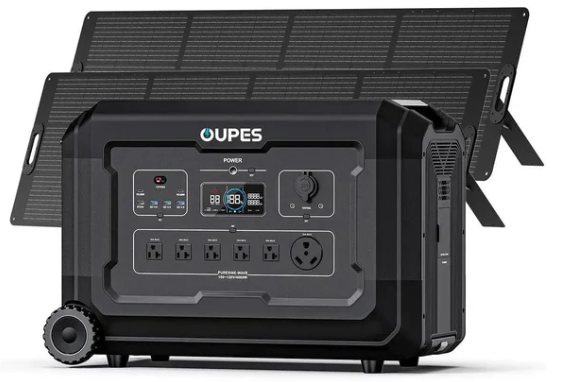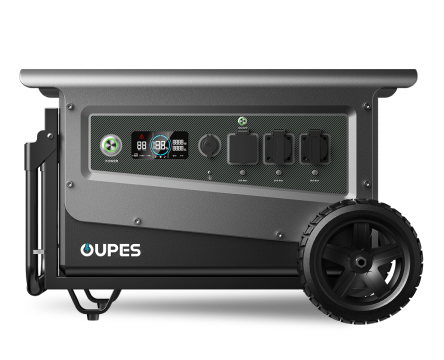
Table of Contents
- Introduction
- Why a Winter Storm Survival Kit Matters
- The Four Essential Items for Your Winter Storm Survival Kit
- Comparison: Basic vs. Advanced Winter Storm Kits
- Additional Recommended Items
- The Role of Portable Power Stations During Winter Storms
- Maintenance and Storage Tips
- FAQ
Introduction
When winter storms strike, they can quickly disrupt essential utilities like power, heat, and communication. In severe cases, a blizzard or ice storm can leave households without electricity for days or even weeks. A well-prepared winter storm survival kit is your first line of defense against these unpredictable events. This guide explains the four most important items to include in your kit, explores additional essentials, and discusses how a portable power station can keep your home and family safe when the grid goes dark.
According to the Federal Emergency Management Agency (FEMA), winter storms cause hundreds of power outages each year in the U.S. Proper preparedness can prevent cold-related injuries and ensure you remain self-sufficient during an emergency.
Why a Winter Storm Survival Kit Matters
1. Extreme Weather Risks
Blizzards, ice storms, and freezing rain can make roads impassable, freeze pipes, and cut off power for extended periods. Temperatures below freezing increase the risk of hypothermia and frostbite, particularly for vulnerable populations. Having a survival kit ready ensures access to warmth, hydration, and communication when you need it most.
2. Power Outage Statistics
The U.S. Department of Energy reports that over 70% of winter power outages result from fallen trees and ice accumulation on power lines. Backup systems, such as solar generators and battery-powered devices, can provide life-saving energy for lighting, heating, and medical equipment.
3. Peace of Mind
Preparedness isn't just about safety—it’s about confidence. Knowing that your family has access to essential resources allows you to stay calm and make sound decisions during a crisis.
The Four Essential Items for Your Winter Storm Survival Kit
1. Emergency Food and Water
Access to food and clean drinking water is the foundation of any survival plan. FEMA recommends at least a three-day supply of non-perishable food and one gallon of water per person per day. Examples include canned soups, dried fruits, protein bars, and ready-to-eat meals (MREs). Store these in airtight containers and check expiration dates regularly.
2. Portable Power Source
A solar generator or portable power station is essential during power outages. Unlike gas generators, these devices run silently, emit no fumes, and can be used indoors. They can power small appliances, medical devices, smartphones, and even space heaters when connected properly. Brands like OUPES offer high-capacity models suitable for home backup or outdoor emergencies, providing peace of mind when electricity is unavailable.
3. Warmth and Insulation
Keeping warm is crucial in freezing temperatures. Include thermal blankets, sleeping bags rated for sub-zero conditions, and extra layers of clothing such as wool socks, hats, and gloves. A small propane heater or battery-powered heating pad can provide additional warmth, but always ensure proper ventilation to avoid carbon monoxide buildup.
4. First Aid and Communication Devices
In an emergency, access to medical care may be delayed. Your kit should contain a comprehensive first-aid kit with antiseptics, bandages, medications, and pain relievers. A battery-powered or hand-crank radio allows you to receive weather alerts, while a charged cell phone with a backup battery or solar-powered charger ensures you can reach help when needed.
Comparison: Basic vs. Advanced Winter Storm Kits
| Category | Basic Kit | Advanced Kit |
|---|---|---|
| Power Source | Batteries and flashlights | Solar generator / portable power station |
| Food & Water | 3-day supply of canned food and bottled water | 5-7 day supply plus water purification tablets |
| Warmth | Blankets and extra clothing | Thermal gear, sleeping bags, and compact heaters |
| Communication | Battery-powered radio | Hand-crank radio, satellite phone, or power backup |
| Medical Supplies | Basic first-aid kit | Expanded medical kit with prescription meds and trauma care items |
Additional Recommended Items
1. Flashlights and Lanterns
Reliable lighting helps prevent accidents and maintains morale during extended blackouts. LED lanterns with rechargeable batteries are ideal, and solar-powered lights offer long-term sustainability.
2. Tools and Equipment
A snow shovel, ice scraper, and multi-tool can be lifesavers. Keep sand or cat litter on hand to improve traction around your home or vehicle.
3. Personal Hygiene Items
Include moist towelettes, hand sanitizer, and biodegradable soap to maintain cleanliness during prolonged outages.
4. Important Documents
Store copies of identification, insurance policies, and emergency contact lists in a waterproof container. These will be vital if you need to relocate or contact authorities.
The Role of Portable Power Stations During Winter Storms
1. Powering Essential Devices
A portable power station can keep critical devices such as heaters, lights, and communication equipment running. Modern models support AC, DC, and USB outputs, making them versatile for various appliances. They can also be recharged via solar panels, wall outlets, or even car adapters — ensuring energy independence even during grid failure.
2. Eco-Friendly and Quiet Operation
Unlike gas-powered generators, solar generators operate silently and do not release carbon monoxide. This makes them safe for indoor use and environmentally friendly. In cold climates, this safety factor becomes especially important when ventilation is limited.
3. Example: OUPES Power Solutions
OUPES offers high-efficiency portable power stations designed for both home backup and outdoor emergencies. Their systems combine LiFePO4 battery technology with advanced battery management systems (BMS), providing reliable power and longer lifespan under cold weather conditions.
Maintenance and Storage Tips
1. Store in a Temperature-Controlled Environment
Keep all survival items in a cool, dry place. Extreme cold can degrade battery performance and cause liquids to freeze or leak. Store water separately to avoid contamination.
2. Rotate Supplies Annually
Check expiration dates on food, water, and medicine every year. Replace or replenish items as necessary to keep your kit effective and ready for use.
3. Test Power Devices Regularly
Run a performance test on your portable power station and solar panels every few months. Ensure all connections, cables, and outlets are in good condition.
4. Keep the Kit Accessible
Store your kit in a central, easy-to-access location. In emergencies, every second counts — don’t bury it under clutter or store it in a hard-to-reach area like an attic.
FAQ
1. What are the four main items in a winter storm survival kit?
The four essential items are emergency food and water, a portable power source, warmth and insulation materials, and a first-aid and communication kit.
2. How long should my survival supplies last?
FEMA recommends at least three days of supplies, but for severe winter regions, a 7-day supply is more practical.
3. Can a portable power station run a heater?
Yes, depending on its wattage. High-capacity models (like those from OUPES) can power small heaters, lights, and medical devices safely.
4. What type of food is best for storage?
Non-perishable, calorie-dense foods such as canned meats, granola bars, and freeze-dried meals are best.
5. Do solar generators work in winter?
Yes. While snow may reduce sunlight temporarily, solar generators still charge efficiently during daylight hours, even under cloudy conditions.
6. How should I maintain my winter storm kit?
Inspect your kit twice a year, replace expired items, and ensure your power sources are fully charged before the winter season begins.




























